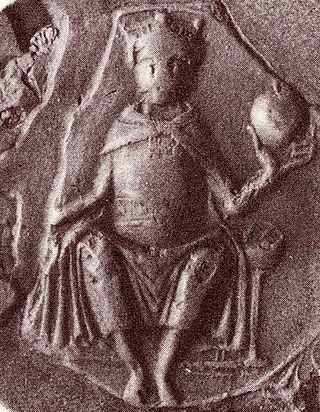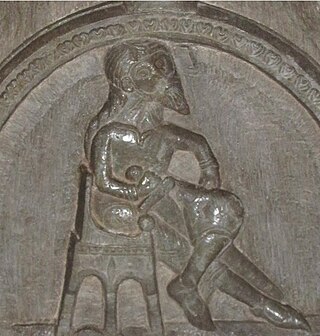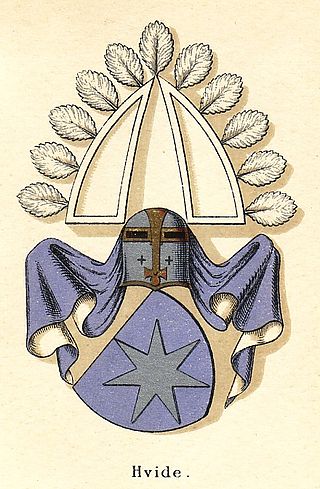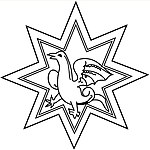Background
In most older literature Kol is called Kol Sverkersson, based on an unverifiable assumption that he was a son of King Sverker I of Sweden. The only source that says anything about his parentage is, however, a medieval genealogy copied by Olaus Petri in the 16th century: "Suercherus Rex senior ... genuit Carolum Regem et Johannem ducem et Sunonem Sijk ... Johannes dux genuit Koll Regem, Ubbe fortem et Burislevum Regem". [1] In other words, the genealogy claims he was a grandson of Sverker and a son of Prince John, and that his brothers were Ubbe the Strong and King Burislev. [2] [3] A medieval list of donations indicates that the mother of Kol was called Ragnhild. She might have been a relative of the jarl Guttorm who donated land to Vreta Abbey on her behalf. [4]
The suggestion that he was a son of Sverker is based on a Danish source which mentions that Sverker had a son Boleslaw (Burislev). This son has been identified by some historians (such as Nathanael Beckman in Svenskt biografiskt lexikon ) as the throne contender by the same name, and thus Kol has also been assigned Sverker I for a father. [2]
Strife for kingship
Prince John was killed in an incident by the Swedish peasantry around 1152. Since he was a young man at his death, his sons must still have been infants. Kol's uncle Charles VII of Sweden was killed by Canute I of Sweden on Visingsö in 1167. Now Kol was recognized at least in parts of Sweden, presumably in Östergötland which was the basis of the dynasty's power. He held the throne in opposition to Canute for a few years, in tandem with his brother or uncle Burislev. The short chronicle of the Westrogothic law relates the few known details: "[King Canute I] won Sweden with his sword and killed King Kol and King Burislev, and had many battles against Sweden and was victorious in them all". [5] A little more is known about Kol from medieval donation lists. He owned land in Frönäs on Öland and donated it to his mother Ragnhild, who in turn gave it to Vreta Abbey when she entered the abbey as a nun. [4] A papal letter from 1171 or 1172 mentions a "K." who was king of the Swedes and Geats; it is not clear whether Kol or Canute (Knut) is meant. [6] Kol was probably killed in battle or murdered by Canute's men around 1173. A 14th-century source claims that he was killed at Bjälbo. [2] [3] After his death, his kinsfolk donated land to Vreta Abbey for his soul, indicating that they were able to keep properties after Canute's victory. [7]
Though some sources affirm that Kol actually was King of Sweden for a few years, the Swedish Royal Court does not recognize him as such in its official list of rulers.
Richeza of Poland, a member of the House of Piast, was twice Queen of Sweden and once Princess of Minsk through her three marriages.

Eric "X" was the King of Sweden between 1208 and 1216. Also known as Eric the Survivor, he was, at his accession to the throne, the only remaining son of King Canute I of Sweden and his queen. The name of his mother is not known, but may have been Cecilia.
Sverker II or Sverker the Younger was King of Sweden from 1195 or 1196 to 1208 when he was defeated in the Battle of Lena by Prince Eric. Sverker died in the 1210 Battle of Gestilren where his forces battled those of King Eric X.

Canute I was king of Sweden from 1173 to 1195. He was a son of King Eric the Saint and Queen Christina, who was a granddaughter of the Swedish king Inge the Elder.

Charles VII or Carl was ruler of Götaland, and then King of Sweden from c. 1161 to 1167, when he was assassinated in a military attack by Knut Eriksson who succeeded him as Canute I.

Sverker I or Sverker the Elder, murdered 25 December 1156, was King of Sweden from about 1132 till his death. Of non-royal descent, he founded the House of Sverker, the rulers of which alternated with the rival House of Eric over the next century.
Magnus Minniskiöld was a medieval Swedish magnate from the House of Bjelbo. For posterity, he is best known as the father of the renowned statesman Birger Jarl, and the ancestor of the later Swedish kings. He is sometimes believed to have perished in the Battle of Lena in 1208, though the evidence is not conclusive.
Boleslaw was a Swedish pretender for the throne, belonging to the House of Sverker. He acted in concert with his kinsman Kol against King Canute I of Sweden, then head of the House of Eric. The two pretenders, who were brothers, half-brothers, or uncle and nephew, may never have controlled much more than the Province of Östergötland, which was the base of the dynasty. Boleslaw is believed either to have been murdered by King Canute's men, or to have fled to Poland in or before 1173.
Magnus II; Swedish: Magnus Henriksson was a Danish lord and king of Sweden between 1160 and 1161. He is often seen by posterity as a usurper.
Erik Årsäll was a semi-historical king of Sweden. His historicity has been called into question. He is dated by some to the end of the 11th century, by others to the 1120s, while more critical historians believe that he is a legendary name belonging to the 10th century. According to some, he was the son of the pagan Swedish king Blót-Sweyn, and, like his father before him, administered the blóts at the temple at Uppsala. However, Erik does not appear in any Swedish or Danish primary sources.
Svantepolk Knutsson was a Swedish knight and councilor. He became a wealthy feudal lord in Östergötland.
Knut Birgersson was Riksjarl of Sweden. He was the eldest surviving son of Riksjarl Birger Brosa and a member of the powerful House of Bjälbo also known as the House of Folkung (Folkungaätten).
Helena or Elin, possibly also known as Maer, Mär or Mö, was Queen of Sweden as the wife of King Inge the Elder, and a supposed sister of King Blot-Sweyn of Sweden.

Helen of Sweden was a Swedish princess and daughter of King Sverker II of Sweden. She was the mother of Queen Catherine of Sweden. She was later Abbess of Vreta Abbey.

Benedicta Hvide also called Benedicta Ebbesdotter was Queen of Sweden as the first wife of king Sverker II. She belonged to the House of Hvide of Denmark and in Sweden was often called Queen Bengta.
IngegerdBirgersdotter of Bjelbo was Queen of Sweden as the second wife of King Sverker II.
Cecilia Johansdotter of Sweden is the possible name of the wife of King Canute I of Sweden and mother of King Eric X of Sweden. Little is known about her except that she was of aristocratic origins and died sometime after 1193.
Helen, is the assumed name of a medieval Swedish princess and Danish queen, Queen consort of King Canute V of Denmark. The date of her birth is not known; her father was King Sverker I of Sweden and her mother has been assumed to be Sverker's first spouse, Queen Ulvhild.
Benedicta of Bjelbo was a Swedish noblewoman and a central figure in the incident known as the Maiden Abduction from Vreta, wherein she, like her mother, Princess Helen of Sweden before her, and her daughter, Ingrid Svantepolksdotter after her, was abducted from Vreta Abbey by the man she later married. Her abduction was the subject of the folksong "Bridal Abduction of Young Lars" .

John, who died between 1150 and 1153, was the eldest son of King Sverker I of Sweden of Sweden and his queen Ulvhild Håkansdotter. He had a role in the outbreak of a war between Sweden and Denmark in the 1150s.






